Seagate has announced their second generation solid state hybrid drive (SSHD), the Momentus XT 750GB with FAST Factor. The new Momentus XT adds 250GB of total capacity over the first-generation XT as well as double the cache NAND, going from 4GB to 8GB of SLC NAND. Seagate is perhaps most enthusiastic though about what they’re calling FAST Factor technology; a series of on-board software enhancements that give the new Momentus XT an extra performance kick. These new SSHDs boast fast speeds in single drive configuration, which gets really interesting when you pair two in RAID0 as we’ll show in this review.
Just what is FAST Factor? It’s Seagate’s effort to better blend the benefits of the on-board cache NAND with the capacity of the hard drive, and generally refers to their integration of the cache and hardware components on the 750GB Momentus XT. Specific examples of where this comes in to play include things like FAST Boot, where Seagate has portioned off a portion of the NAND, just to handle files needed for booting a computer. FAST Factor also makes the Momentus XT OS independent, by keeping the software contained on the drive itself, there’s no need for a driver, meaning the XT will be at home in any computer. Another bit of good news is that FAST Factor can be updated in the future via firmware updates – case in point, Seagate will be adding FAST Write to the Momentus XT to give the cache multi-directional benefit.
FAST Factor is one key part of the intelligence built into the Momentus XT, the other being Seagate’s Adaptive Memory technology. Similar but smarter than the system used on the first Momentus XT, it identifies usage patterns to keep the most frequently accessed data at the LBA level in the NAND cache for faster access. Each profile will vary based on how an individual uses their drive. As with many caching solutions, it will take a little while to build out the profile, but after just a few loads of regular programs like Outlook, a web browser and Word for instance, the benefits will be obvious to end users.
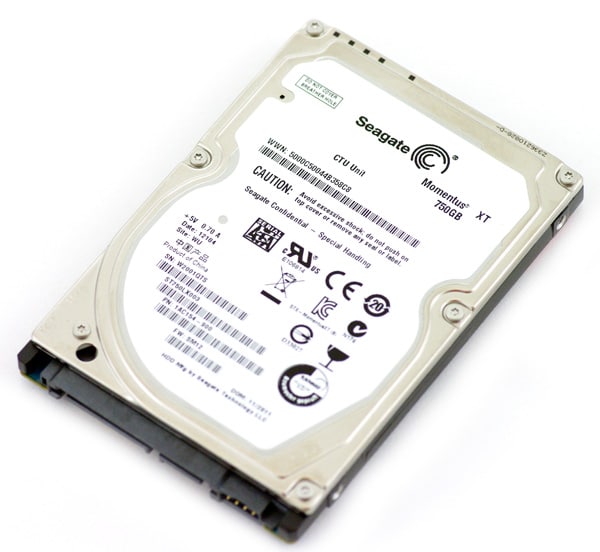
The 750GB Momentus XT maintains the 2.5" form factor but has an updated SATA 6Gb/s interface. The hard drive has a 7,200RPM spin speed, with 32MB drive cache, four heads and two disks. Seagate offers a five year warranty with the drive. The Momentus XT drive is shipping now in a single 750GB capacity, with an MSRP of $245.
Seagate Momentus XT 750GB Specs:
- Interface: SATA 6Gb/s with NCQ
- 2.5" 9mm body
- 8GB SLC Flash
- Capacity: 750GB (698.63GB Formatted)
- Cache: 32MB
- 4K sector size
- >600,000 Load/Unload Cycles
- Spindle Speed: 7200 RPM
- Unrecoverable read errors: 1 in 10^14
- Average idle power: 1.1W
- Average seek power: 3.3W
- Acoustics (Idle Volume): 2.3 bels
- Acoustics (Seek Volume): 2.6 bels
- Operating Shock 350G, 1000G Non-Operating
- Weight: 115g
- Size: 69.85 x 100.35 x 9.5mm
Aesthetics
The Seagate Momentus XT 750GB hybrid hard drive doesn’t really look that much different than a normal hard drive. In fact, Seagate uses the same internals on the new XT that were used in the 750GB Momentus. The drive has the standard Seagate drive appearance with a simple all-white label on top of a minimalistic silver cover and black metal body.
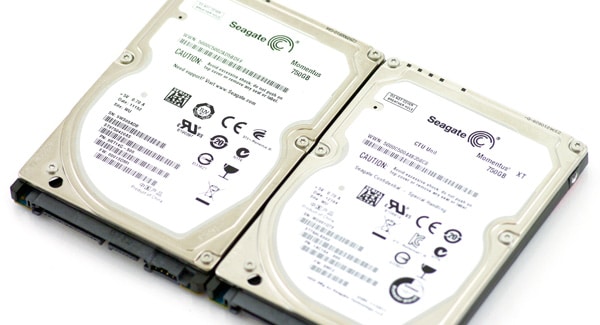
When we flip it over it keeps the same look, hiding its hybrid secrets on the inner-facing side of the circuit board. To the naked eye nothing about this drive indicates that it is unlike any other notebook drive on the market.
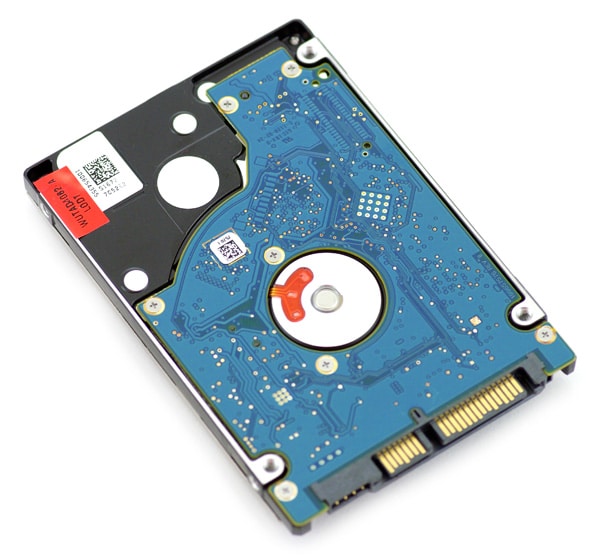
Build quality is good for a consumer notebook drive. Seagate rates the operating shock at 350G, meaning this drive can survive a pretty good impact like what you might experience if you drop your notebook. The PCB (printed circuit board) has all soldered components facing the drive body to shed heat and protect components from getting hit accidentally.

The front and sides are fairly basic as far as hard drives and SSDs go these days, although Seagate did include four jumpers on the front next to the SATA power and data connection.

Disassembly
Taking the drive apart was easy after removing seven precision Phillips head screws. With the circuit board removed we finally get to see what makes this drive so special. This drive uses two controllers, one for the flash memory segment and another for the standard hard drive operations.
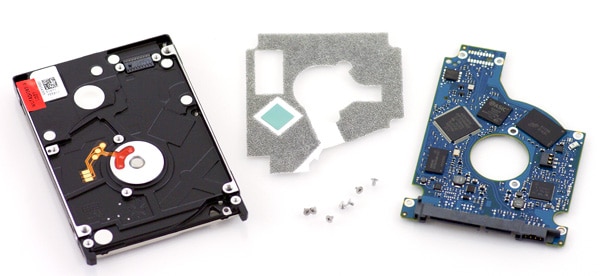
With the board removed on the Momentus XT 750GB and Momentus 750GB we get a closer look to see the drives differences and similarities. Both drives with the circuit boards removed are identical down to the machining of the drive surface. Looking at the circuit board we can also see that both drives use the same HDD controller and motor driver. That is where the similarities end though.
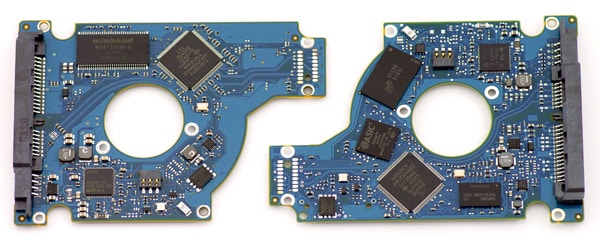
The Momentus XT 750GB has a 8GB Micron SLC NAND module packed closely to an eASIC controller for the SSD segment of the drive. The standard platter interface is managed by a Seagate/LSI controller. Finishing off the design is a larger 32MB Samsung DDR RAM cache module, up from 16MB seen in the 750GB Momentus. Comparing the XT 500GB to the newer XT 750GB though, only the NAND and interface speeds have changed besides the overall capacity difference.
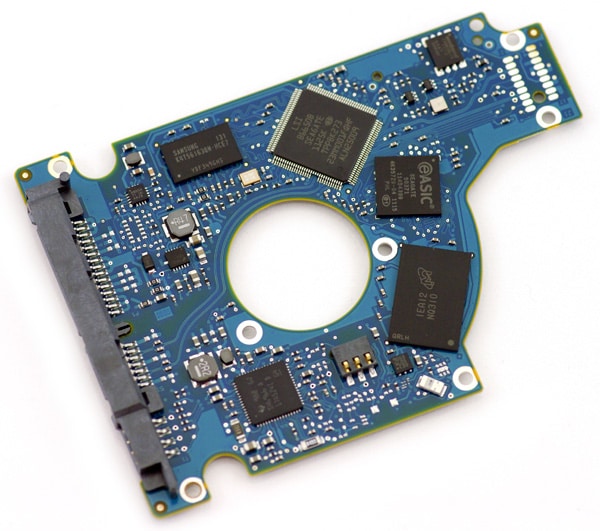
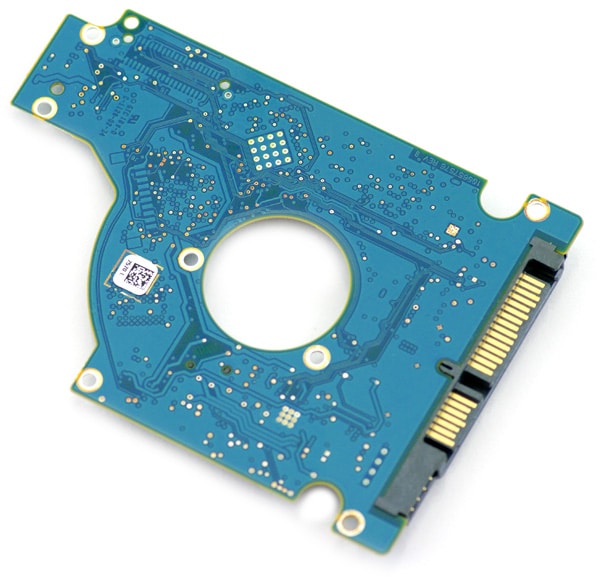
When it comes down to the circuity behind the Momentus XT 750GB and the older 500GB model before it, it really is quite impressive at how Seagate can take a standard notebook hard drive and make it a hybrid storage device with a simple PCB swap.
RAID Notebook Usage
As we mentioned at the start of this review, we were very interested to see how these new Momentus XT 750GB hybrid drives perform in RAID0. To test this configuration we turned to our trusty Lenovo ThinkPad W520 and used its dual 2.5-inch hard drive bays and SATA 6Gb/s support. To keep performance data consistent with other drives also benchmarked on this system, we maintained the same clone image across the pair of Momentus XT 750GB’s as well. We used FutureMark PCMark Vantage for this comparison.
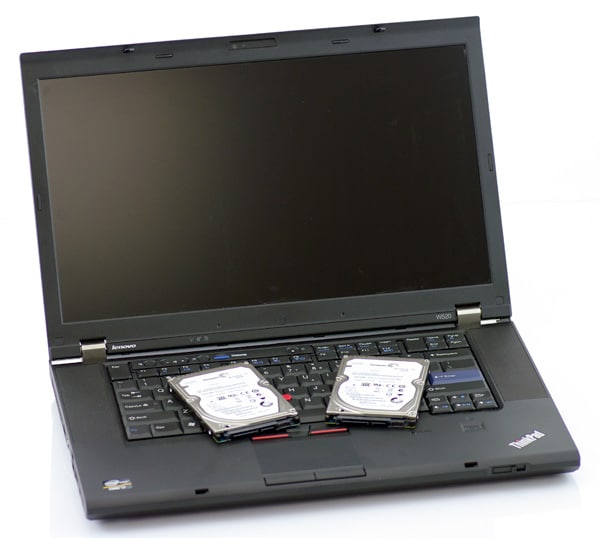
To see peak performance through the caching mechanism we looped the benchmark four or five times in succession before the speeds leveled off. This method is consistent with our real-world benchmarks that we discuss later on. The new Momentus XT 750GB drives performed very well against their predecessors, boasting a 13.1% overall system performance bump and a 38% storage specific improvement.
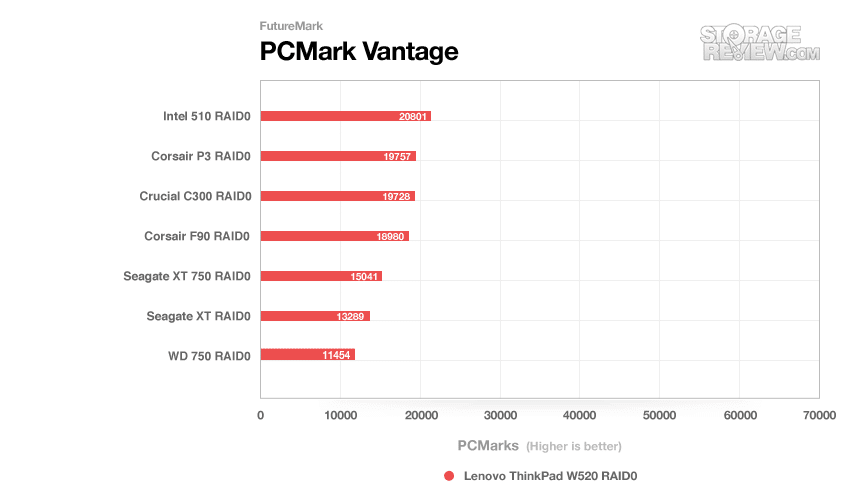
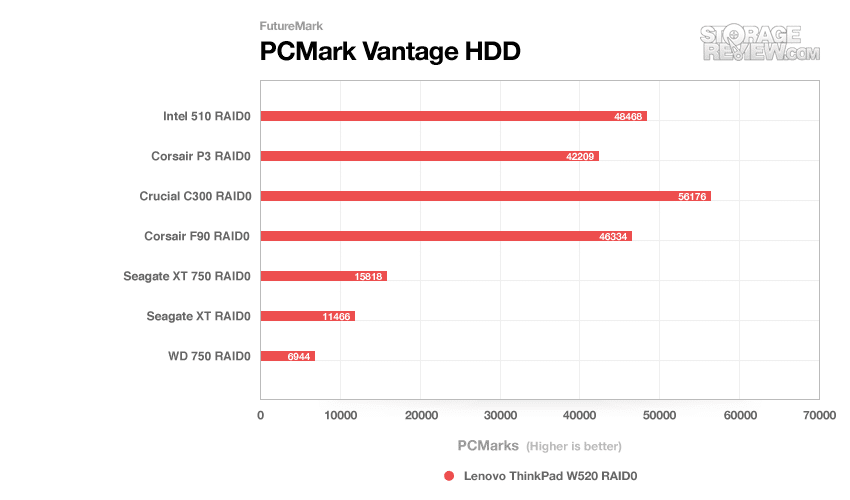
The hybrid drives were still a ways off from fully competing with the modern SSDs also tested in this system, but they performed admirably when you consider they offer 1.5TB of disk space in RAID0.
Synthetic Benchmarks
The performance benchmarks outlined in this review can be categorized into two sections. The first is the standard IOMeter and CrystalDiskMark section which uses randomly generated data/file sequences and the second being repeatable traces. Normally most drives interact with both sets of benchmarks in the same manner, but the Seagate Momentus XT is different. In our IOMeter and CrystalDiskMark tests you will only see raw performance, which normally might translate into real world scenarios. Since the Momentus XT actively caches repeating data patterns, its full performance won’t be seen in the first half of our tests.
Our first benchmark looks at the Momentus XT 750GB’s straight line performance with a 2MB sequential transfer in IOMeter.
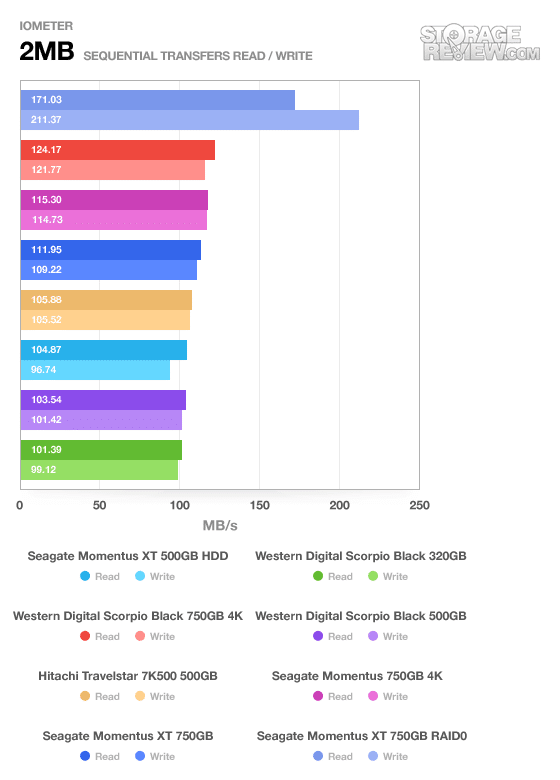
The Momentus XT 750GB performed well with a read speed of 111.95MB/s and a write speed of 109.22MB/s, but was edged out by the standard Momentus 750GB non-hybrid drive as well as the Western Digital Scorpio Black 750GB. These single-drive though were no match for the RAID0 configuration of the XT 750GB though, which topped out at 171MB/s read and 211MB/s write on our LSI MegaRAID 9260-8i inside our server platform.
The next benchmark keeps the 2MB transfer size but changes from a sequential to random transfer.
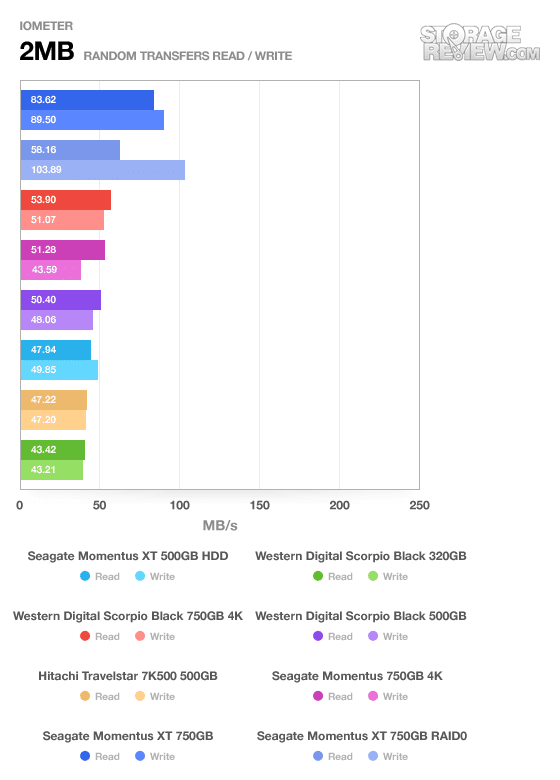
In the 2MB random transfer test the Momentus XT 750GB topped the charts working in a single drive configuration, with speeds topping 83MB/s read and 89MB/s write. The non-hybrid Momentus measured just 51MB/s read and 43MB/s write.
Switching to an even smaller random transfer test our next IOMeter benchmark measures the random 4K read and write speeds of each drive.
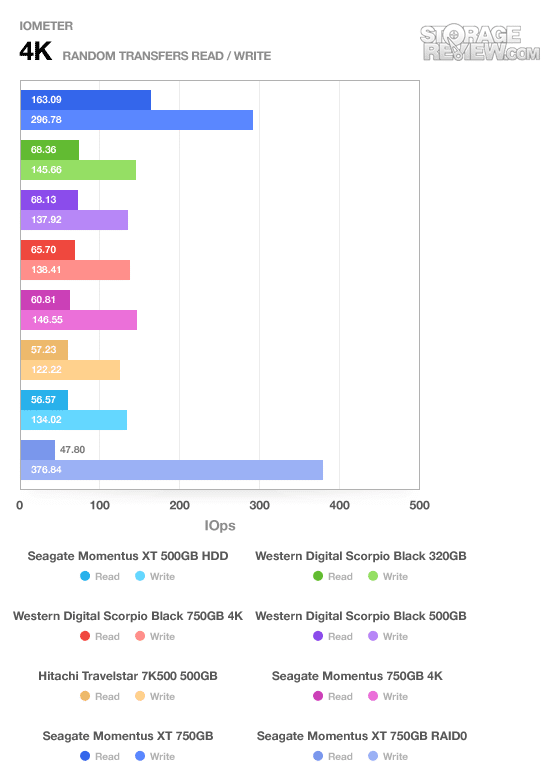
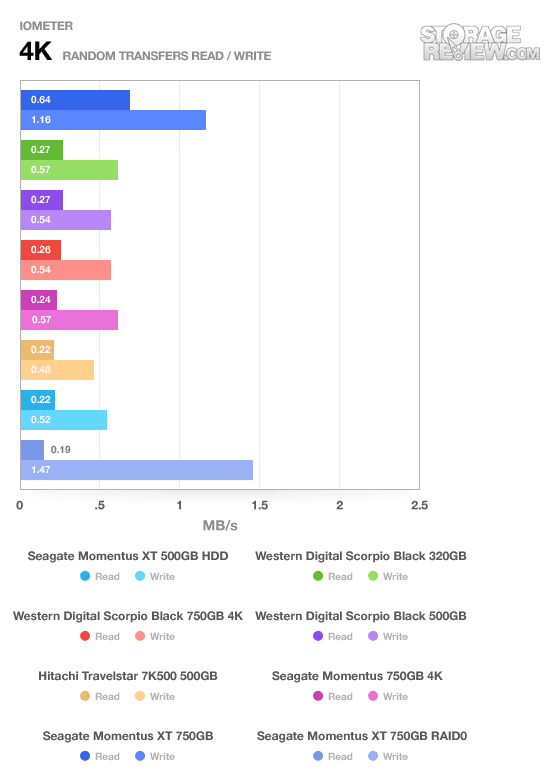
The Seagate Momentus XT 750GB had a huge lead over any of its competition, with a random read speed of 0.64MB/s and a write speed of 1.16MB/s. The closest drive managed just 0.27MB/s read and 0.57MB/s write in comparison.
With an incredibly strong lead in random 4K write speed, the 750GB Momentus XT had no trouble nearly halving the average write latency compared to its competition. Its peak latency scored towards the bottom of the chart with 38.41ms, with the WD Scorpio Black 500GB leading with just 20.9ms.
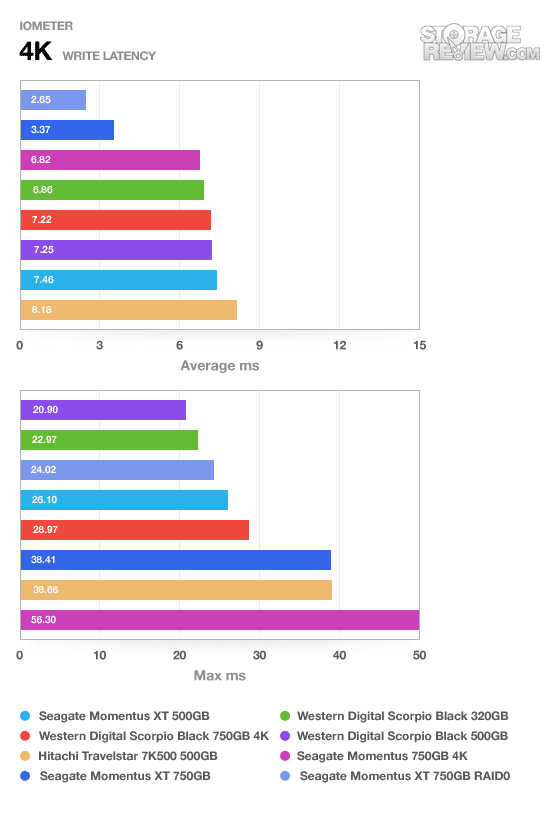
Our next set of synthetic benchmarks look at the inner and outer edge performance of the 750GB Seagate Momentus XT, with the outer edge being fastest and the inner edge being slowest. This is a good example of best and worst case performance, since depending on where the data sits on the rotational media it could be in an advantageous or unfavorable position depending on file system or partition layout.
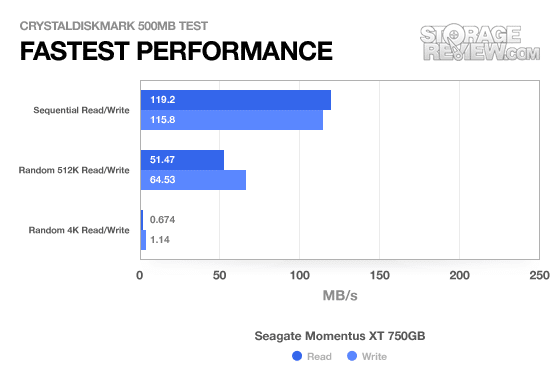
Peak speeds topped out just shy of 120MB/s read and write.
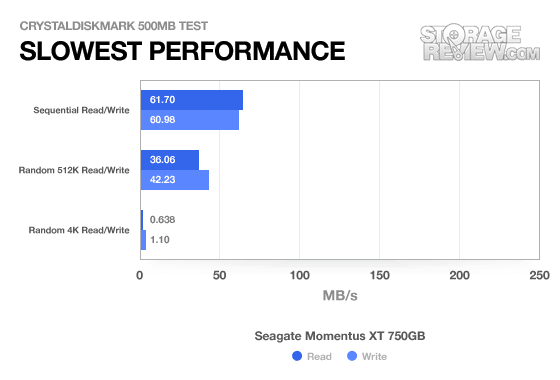
On the inner track of the 750GB XT data streamed at roughly 60MB/s read and write.
Our final group of synthetic benchmarks looks at server and workstation scenarios, which offer a mixed read/write workload and stress the drive under a varying level of queue depth. This gets closer to what you might see in the real world, although the data is still far from what you would see in practice. The Momentus Xt 750GB showed very promising results across the board, in some cases having almost triple the speed of the comparables.
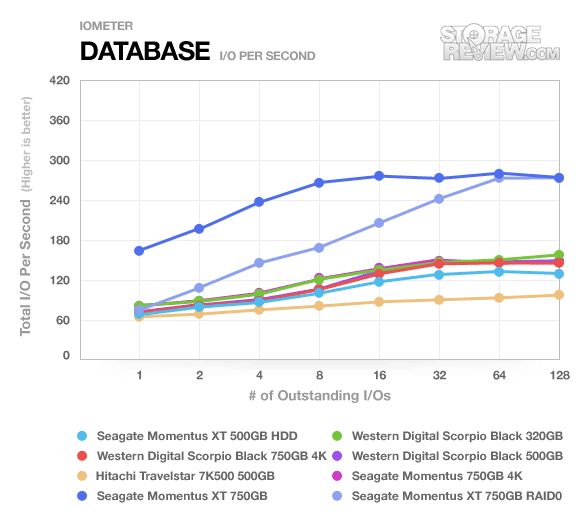
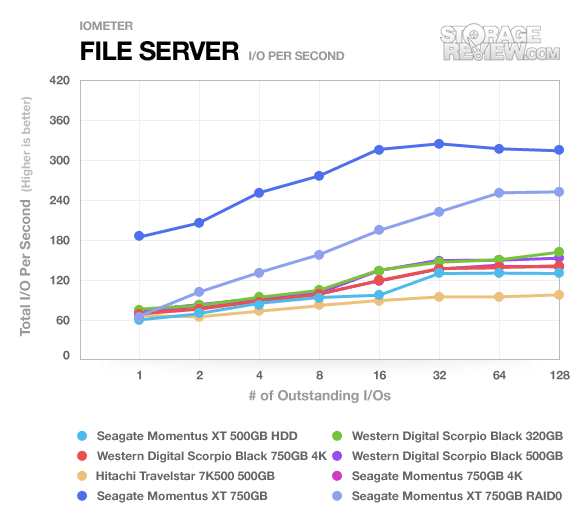
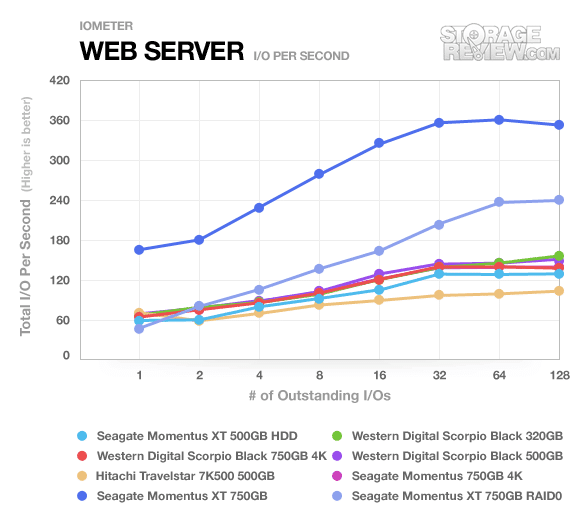
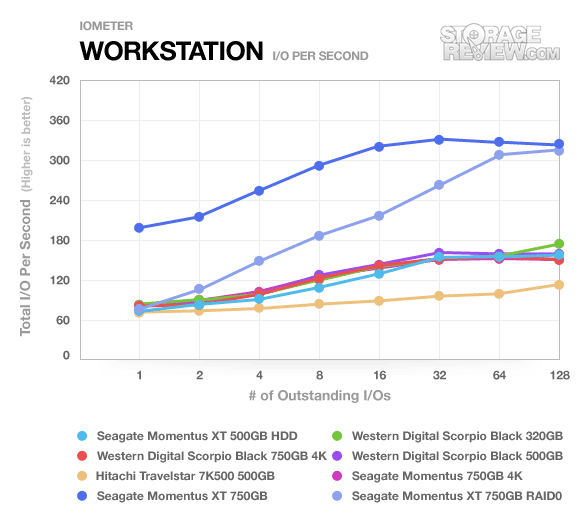
Real-World Benchmarks
If you are new to StorageReview, one thing we try to focus on is how any given drive might perform under real-world conditions. For the average user, trying to translate random 4K write speeds into an everyday situation is pretty difficult. It helps when comparing drives in every setting possible, but it doesn’t exactly work out into faster everyday usage or better game loading times. For this reason we turned to our 4K-optimized StorageMark 2010 traces, which include HTPC and Gaming to help readers find out how a drive might rank under their conditions.
The first real-life test is our HTPC 4K scenario. In this test we include: playing one 720P HD movie in Media Player Classic, one 480P SD movie playing in VLC, three movies downloading simultaneously through iTunes, and one 1080i HDTV stream being recorded through Windows Media Center over a 15 minute period. Higher IOps and MB/s rates with lower latency times are preferred. In this trace we recorded 2,986MB being written to the drive and 1,924MB being read.
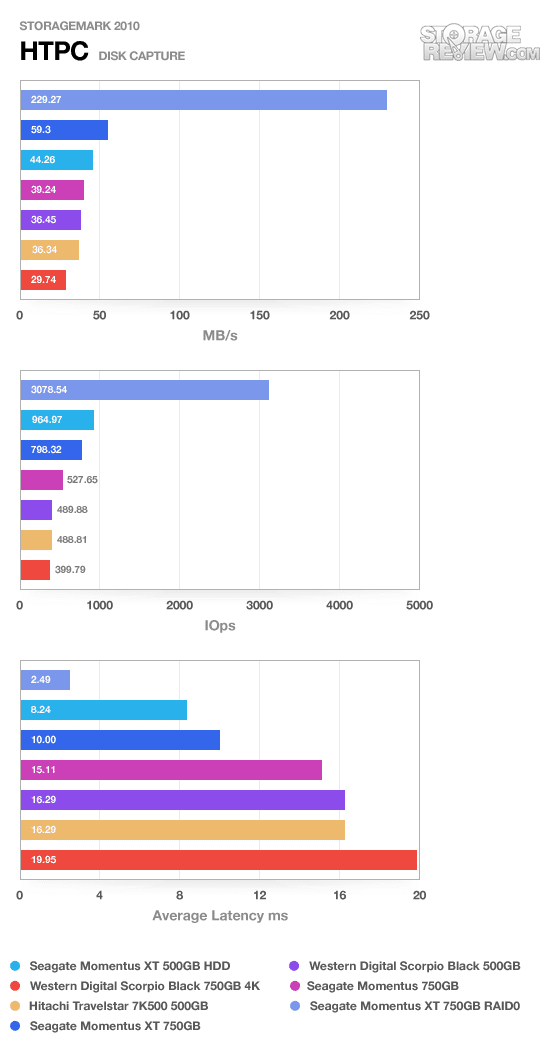
In the HTPC trace the new Momentus XT 750GB pushed far ahead of the previous generation XT, with a performance increase of 34%. This doesn’t even come close to the RAID0 performance though which screamed past with an average speed of 229MB/s, which worked out to a 286% jump over the single XT 750GB.
Our next real-life test covers disk activity in a gaming environment. Unlike the HTPC trace, this one relies heavily on the read performance of a drive. To give a simple breakdown of read/write percentages, the HTPC test is 64% write, 36% read, the Productivity test is 59% write and 41% read, while the gaming trace is 6% write and 94% read. The test consists of a Windows 7 Ultimate 64-bit system pre-configured with Steam, with Grand Theft Auto 4, Left 4 Dead 2, and Mass Effect 2 already downloaded and installed. The trace captures the heavy read activity of each game loading from the start, as well as textures as the game progresses. In this trace we recorded 426MB being written to the drive and 7,235MB being read.
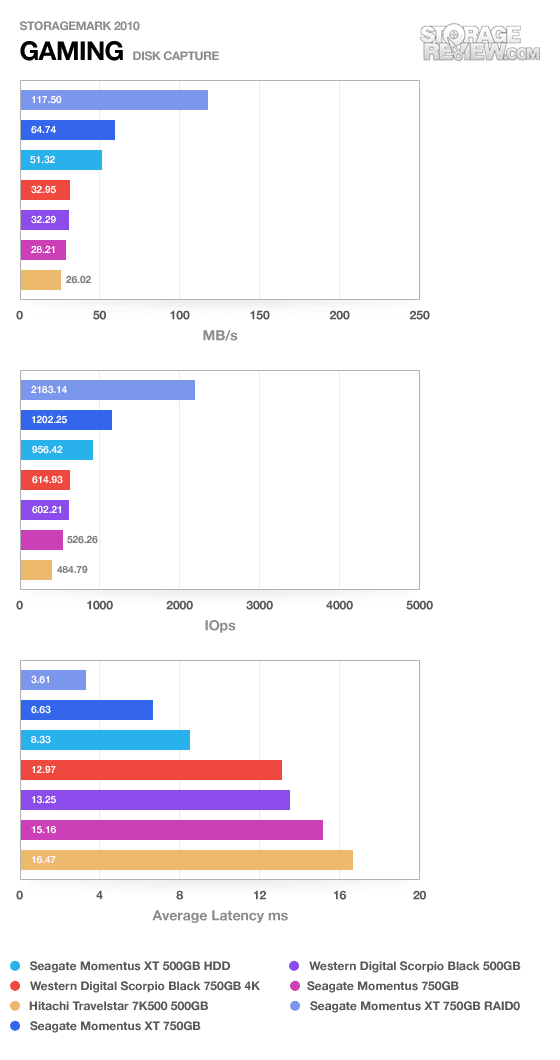
In the gaming trace the single Momentus XT 750GB measured 64.74MB/s average, offering an increase of 26% over the 500GB XT. The two 750GB XTs in RAID0 measured 117.5MB/s average, just about doubling the single drive performance.
Power Consumption
When comparing drives used in a mobile platform one of the biggest selling points is low power consumption. With chipsets becoming more and more efficient, key sources of power draw get narrowed down to either the bright screen or the storage device used. In the next test we record the average power consumed over a small range of synthetic benchmarks. For reference, Seagate lists an average idle power rate of 1.1 watts and an active seek rate of 3.3 watts.
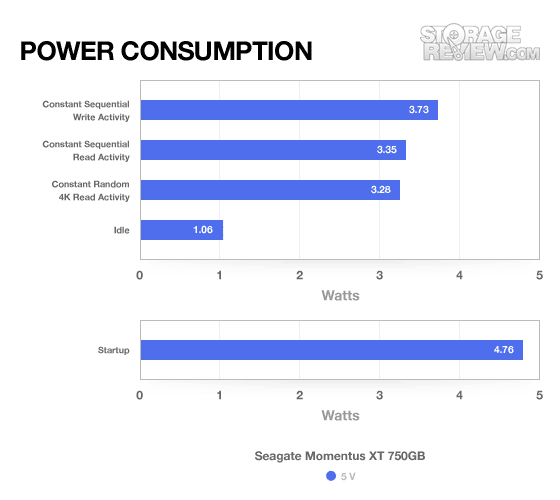
The Seagate provided power values came in spot-on in our tests, with our actual idle rate measuring just 1.06 watts. This value was seen right after the drive parked its head. Active power values ranged from 3.73 to 3.28 watts, with our sequential write pattern being the highest and random 4K read test being lowest. Startup power requirements neared almost 1A, measuring 4.76 watts to get the twin platter assembly up to operating speed.
Warranty
Seagate offers the same 5-year warranty on the Momentus XT 750GB as they do on all their other spindle hard drives. This compares to an average of 3 years on most consumer SSDs with a handful offering 5 year warranties. One of the primary reasons behind this is the fact Seagate uses SLC NAND flash whereas most consumer SSDs use MLC NAND flash. SLC has a useful life of around 100,000 write cycles with MLC reaching its limit at 3-5,000 write cycles. On the flip side during average use most consumer MLC-based drives won’t be pushing as much data through each individual memory cell like the Momentus XT 750GB will as it continuously replenishes its 8GB cache stores.
Conclusion
The Seagate Momentus XT 750GB with FAST Factor doubles the cache NAND and adds a 50% capacity boost when compared to the 500GB first generation Momentus XT. While it’s easy to look at something like FAST and shrug it off as marketing hype, the new Momentus XT showed that the added cache and software do make a difference, boasting a 34% increase in performance in our HTPC real world test and a 26% gain in our gaming trace. It gets even better for the generation two XT when you look at some of the synthetic tests like the IOMeter server profiles.
While most of the performance stats show a nice improvement, power was one area where the newer model did start to tip the scales compared to the previous generation mode. That said, the drives overall did very well in RAID0, giving desktop users and some notebook users 1.5TB of speedy hybrid storage. For a driver-free hybrid solution, its hard to beat a pair of Momentus XT 750GB drives in RAID0.
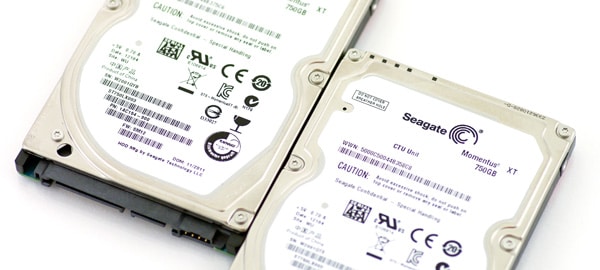
The big question buyers will need to consider is price per GB. The original 500GB XT has a street price of $150-160 right now, while the 750GB XT has an MSRP of $245. We’ll quickly see what street pricing turns out to be, but that appears to be a big premium. For those craving performance and capacity though, the price may not matter. And to be fair, Seagate has committed to improving the drive over time, they’ve already announced plans for a firmware update to enable FAST Write, to give writes to the drive some caching advantage.
Pros
- 50% more space the 500GB XT
- Big performance gains over previous generation hybrid drive
- Faster raw transfer speeds than standard 750GB Momentus
- Works well in RAID
Cons
- Price premium with $245 launch price
Bottom Line
Seagate set out to improve their first generation hybrid with the release of the Momentus XT 750GB SSHD and they did just just that across all areas of performance. When it comes down to a purchase decision though, an MSRP of $245 might have some buyers thinking harder than Seagate would like. At the end of the day though, the capacity and performance equation is very favorable, giving the new Momentus XT plenty of opportunity to find its market.




 Amazon
Amazon